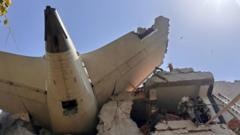Air India Flight AI171, a Boeing 787-8 Dreamliner, crashed shortly after takeoff from Ahmedabad, resulting in the deaths of 241 people. Officials are investigating potential causes, including rare double engine failure, bird strikes, and possible pilot errors regarding flight configurations.
Investigation Underway Following Air India Plane Crash Moments After Takeoff

Investigation Underway Following Air India Plane Crash Moments After Takeoff
The tragic crash of Air India Flight AI171 just after departing from Ahmedabad raises questions about possible causes, including engine failure and pilot error.
On Thursday afternoon, Air India Flight AI171 took off from Sardar Vallabhbhai Patel International Airport in Ahmedabad, India, only to crash 30 seconds later, resulting in the loss of 241 lives onboard and additional casualties on the ground. Indian investigators are set to collaborate with experts from the US and UK to determine the factors leading to this fatal incident involving the Boeing 787-8 Dreamliner, which had never faced such an occurrence since its introduction into commercial service in 2011.
The aircraft was piloted by seasoned Captain Sumeet Sabharwal and co-pilot Clive Kundar, who collectively had more than 9,000 flight hours. After a routine taxi, the flight took off at 13:39 local time, carrying approximately 100 tonnes of fuel. A mayday call was recorded shortly after takeoff, followed by a significant explosion that was captured on video as the plane descended rapidly in a heavily populated area of Ahmedabad.
Aviation experts have suggested several potential causes for this catastrophic failure, including the remote possibility of a double engine failure, a scenario almost unprecedented in modern aviation. Such a failure could stem from fuel contamination or blockages in the fuel system, which might deprive the engines of the necessary power. Another expert raised the issue of bird strikes, a known threat in the Ahmedabad area, highlighting the airport's historical record of bird strike incidents that exceeded 462 over a five-year period.
Other theories surrounding the crash include the critical role of flaps during takeoff. Flaps are designed to optimize lift at lower speeds, and the failure to deploy them correctly could lead to an inability to climb. Given the heavy load and high-temperature conditions at the time, improper flap configuration might have exacerbated the situation. The aircraft's systems are engineered to warn pilots in situations of incorrect configurations before takeoff, suggesting that if an error occurred, it may point to human oversight.
As experts examine the recovered black box and debris, the investigation aims to reconstruct the final moments of Flight AI171, seeking clarity in this tragic event that has underscored the complexities and risks of aviation operations in challenging conditions.




















